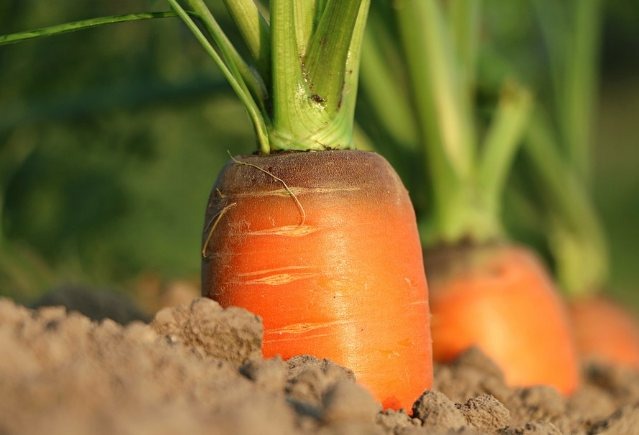Carrot Growth Stages - Growth Speed of Carrots
Written by Ivy
Jan 06 2023

If you've chosen to try your hand at growing the root vegetable, you'll need to learn about the stages of carrot growth. They take two years to complete their entire life cycle because they are considered biennials.
We'll go over all the stages of carrot growth in this article, along with any other information you might need.
Quick Overview:
- Stage 1: Seed Germination
- Stage 2: Seedling Growth
- Stage 3: Vegetative Growth
- Stage 4: Reproductive Growth
What Are the Different Carrot Growth Stages?

Four stages make up the four phases of the carrot growth cycle. Seeds are sown in early spring or late summer when the soil is cold, and germination starts within two weeks. As a result, the carrot plant develops leaves, roots, and stems during the first three stages of growth.
The plant will start to flower and set seed when it has reached the reproductive stage. Here are more details on each carrot growth stage:
Stage 1: Seed Germination
The first few weeks following carrot seed sowing are when germination starts. The seed absorbs water and swells, the seed coat breaks open, and a small root grows downward into the soil. A carrot seedling also begins to incline its growth upward in the direction of the light.
Stage 2: Seedling Growth
It's a slow, steady growth phase starting with the seedling developing its first true leaves, and the roots continue to grow longer and thicker into characteristic carrot taproot. The seed is still the plant's only source of food at this point.
Stage 3: Vegetative Growth
The carrot plant grows more leaves, gets taller, and starts photosynthesis to fuel its growth. Rapid tuber growth and carrot top growth are the results of this. During the next few weeks, the root grows longer and thicker, with "shoulders" emerging from the ground. Near the conclusion of this phase, the carrots will be ready for harvesting.
Stage 4: Reproductive Growth
If the carrot is not harvested, the plant goes into dormancy to withstand cold temperatures, which causes the top to dieback and the growth to stop.
New shoots appear in early spring, and as the temperature rises, the plant starts a rapid upsurge in growth, called "bolting." The flowers bloom in the umbrella shapes, and eventually, the plant sets seeds, ending its life cycle.
What Do Carrot Plants Need to Grow?
The bright sun and cool soil temperature are ideal for growing carrots. Nearby plants on a raised bed will help keep the soil from becoming too hot. To produce the tasty carrots, make sure the moisture level is constant. The specific requirements are listed below.
Soil
Because they are a root crop, carrots require loose, deep, and well-drained soil for proper growth. Add some organic matter and a few handfuls of sand to your soil to help it become more pliable if it is too dense. Prepare the soil with a spade or tiller to a depth of 12 inches and remove rocks or other debris that might impede carrot growth.
Sunlight
Carrots need full sun to grow properly, so make sure to plant them in a spot with six hours minimum of daily sunlight. If you live somewhere hot, some afternoon shade will keep the carrot roots from overheating.
Watering
Carrots require about 1 inch of water each week, although the need varies depending on carrot development stages. When the plant is in its vegetable stage, it needs water more frequently; during the reproductive stage, less frequently.
Fertilizer
Nitrogen fertilizer has a negative impact on carrots because they are not heavy feeders. Too much nitrogen produces lush foliage but causes small, stunted roots. The best fertilizer for carrot growth is either composted manure or a balanced fertilizer.
The Full Lifespan of a Carrot Plant
Because the carrot is a biennial plant, it takes two years for it to go through its entire life cycle. Growing leaves, roots, and stems takes up the first year of a plant's life. In the second year, the plant enters a dormant phase over winter and begins to flower in the spring of the second year. It eventually sets seeds and dies in the summer.
However, the majority of carrots are picked in the first year, before the plant starts to reproduce. That means that most carrots never get a chance to flower or set seeds. Instead, while they are still in the vegetative stage of growth, they are pulled from the ground and eaten.
Here is a short summary of changes that occur over the lifespan of a carrot plant:
- There are two growing seasons for carrots, depending on the climate. You can either sow carrot seeds as soon as the soil can be worked in the spring — suitable for the cold climate or plant seeds in late summer or early fall and get a winter crop — ideal in hot climates.
- From October to November, carrots that were planted in the late summer will be ready for harvest. For the spring crop, harvest time is typically June to July. However, this will change depending on the type of carrot and the weather. Carrots can usually be harvested 75 to 80 days after planting.
- As the plant matures, the carrots can stay edible in the ground for two to four weeks before they harden and become woody. In cooler weather, this time frame can be extended by an additional week.
- The carrots will grow small, stunted, and woody if you don't pick them because the plant will start using the roots as fuel. At the same time, the green top will become larger and start the reproduction process by flowering.
- A carrot plant that is fully grown can grow as tall as 2 feet. But some dwarf varieties only grow to about 6 inches. Depending on the type of carrot, the plant's width will also vary, but they are typically around 8 inches.
- As the plant nears its death after completing its life cycle, it starts to bolt. When a plant bolts, it creates a tall, slender stem with a flower on top. Through the production of seeds, they have the chance to preserve their species.
- Carrot plant bolts into umbrella-like flowers that produce small black seeds. The plant slowly turns yellow and dies once the seeds are fully developed.

Caring for the Carrot Plant
To ensure that your carrot plants mature and yield a good crop, you'll need to take good care of them. Here are some tips on how to do just that:
- As soon as the carrot seedlings appear, begin trimming the plants. To ensure that only healthy seedlings remain, remove any that are weak or lack shape.
- Once the plants are about 4 to 5 inches tall, start trimming the tops to stimulate the plant to concentrate its nutrients in the roots. It also makes it possible for more air and sunlight to reach the plant's interior.
- Because carrots and weeds compete for water and nutrients, weeding is also crucial.
- Carrot plants need about 1 to 2 inches of water per week, depending on the weather conditions. To prevent wetting the foliage, which can cause fungus diseases, water the plant from the bottom up.
Do Carrots Come Back Every Year?
Keep in mind that because carrots are biennial plants, they have a two-year life cycle before dying. As a result, they are annuals and can be grown and harvested as such. To answer the question, YES, carrots reappear each year, but only during the course of their normal life cycle (two years).
The following year, when your carrots are left to overwinter underground, they will produce flowers and seeds, but because they are unable to grow much, the carrots may begin to have a springy and woody texture.
Common Problems During Carrot Growth Stages
Carrot growth is relatively simple, but there may be some problems as they go through their various stages.
Cracked roots, poor germination, insects, missing main roots, deformed roots, and stunted growth are the most common issues.
Let's go over these concerns and determine how to resolve them.
1. Cracked Roots
Although you can still eat carrots that have been cracked, this problem makes them more vulnerable to pests and illnesses.
Insufficient watering is to blame for this. Either you overwater them and the soil becomes soggy, or you underwater them and the soil becomes dry and compact.
Depending on the local climate and humidity levels, you should water your plants at least once a week. If the top few inches of the soil appear to be dry, I would advise you to water them once more.
2. Failed Germination
If more than a few weeks have passed since the carrot seed was planted and no sprouts have shown up on the surface, then there must have been a problem with the germination process.
It might be a soil issue or a moisture issue.
This makes it challenging for the tiny shoots to move in heavy soil, which is why we advised you to loosen the soil before planting earlier in the article. Compost can also be used to soften the soil.
Due to their rapid growth and ability to make the soil pliable for taproot development, growers frequently plant carrots and radishes together. To prevent them from affecting the growth of the carrots, radishes are harvested before the latter.
3. Insect Invasion
Your root crops will be ruined by carrot flies' eggs, which hatch into root-eating maggots.
Carrot seeds can be planted in raised beds to avoid this by keeping the aphids away from the plant. To keep these bothersome pests away from your plant, you can also try companion planting.
For instance, onions make the ideal companion plant for carrots. Carrot and onion growth stages are somewhat comparable, and both are biennial plants grown primarily for their roots.
Insecticides can also be used to kill them, but doing so may alter the size and flavor of your crops.
4. Main Root Not Formed
You end up with many secondary roots that are regrettably inedible and unable to develop into carrots, rather than one main root that will produce carrots.
The presence of too much nitrogen in the soil is what causes your plant to concentrate primarily on developing secondary roots. These roots will continue to expand and mature while also absorbing the nitrogen needed to produce new foliage.
Use a fertilizer with low nitrogen content and switch to one with phosphorus and potassium that only focuses on root development to prevent this.
5. Malformed Roots
The root crops must first be harvested before you become aware of this problem. The wrong types of soil conditions can cause them to twist or fork.
The soil may not be loose enough, or you may not have taken out all the rocks, stones, and soil clumps from the area where you planted the carrots.
Another potential cause of this is the premature application of compost or manure, which occurs before the roots have had time to establish.
6. Leggy Seedlings
Leggy seedlings indicate spindly roots, so keep this in mind if you see them growing. Low temperatures and dense planting are the primary causes of spindly roots.
To prevent this, eliminate weeds by hand during the early stages of carrot growth, and then add mulch to maintain the ideal soil temperature.
7. Green Tops
As your carrots will eventually rise above the soil's surface and be exposed to sunlight, it is not unlikely that their shoulders will turn green. The carrots turn green as a result of reflecting chlorophyll.
Although they can taste a little bitter compared to typical orange carrots, these parts are safe to eat.
To prevent this, cover them with mulch or an additional layer of soil to shield them from the sun.
8. Green Cores
The cores of your carrots may occasionally be green due to unfavorable or frequently altering environmental factors.
For instance, if your plant has been kept dry for a while and is then suddenly exposed to moisture, it won't be able to quickly adjust to its new surroundings.
The same is true when fertilizing subpar soil.
9. Root Knot Nematodes
The presence of nematodes in your soil is likely indicated by the knotty appearance of your root crops.
You should thin the seedlings earlier to prevent these pests, and you can get rid of them with neem oil or fungicide.
10. White Mold on the Soil
A fungus called Sclerotium rolfsii is responsible for the widespread disease known as southern blight. Since these root vegetables are grown for their nutritious roots, root rot is kind of the worst thing that can happen to them. This disease can cause it.
This is a sign that your carrots have contracted Southern blight because fluffy white mold will start to grow on the soil.
To get rid of it in this situation, use fungicides or fertilizers high in nitrogen. Without a doubt, make sure the soil where you planted them is healthy and fungus-free.
11. Stunted Growth
The most crucial component of your plants, the roots, can't grow and develop if the temperature is fluctuating, which can stunt the growth of your carrot plant.
This covers conditions that are hotter than 80 degrees Fahrenheit and colder than 50 degrees. Because the plants must compete for soil nutrients and water, overcrowding can occasionally also cause stunted growth.

Do Carrots Grow from Seeds?
Seeds are used to grow carrots. Carrot plants can be produced asexually, i.e., by cloning one carrot from another, but this won't cause a new carrot to grow.
If pollinated, the above-ground foliage will grow again, flower, and yield carrot seeds, but it won't yield another edible taproot, i.e., carrots. In its place, roots can be seen growing from the top, sides, and bottom of the old carrot if you dig it up from the ground.
Clones of carrots grown in a garden will produce seeds that are a hybrid of the two parent plants when allowed to flower and set seed. It won't be an exact replica of the carrot it originated from. This is due to the fact that the majority of carrots are grown from hybrid seeds, which were crossed to create a hybrid with specific qualities like higher yields and disease resistance.
Do Carrots Need Pollination?
To produce carrots, a carrot plant does not require pollination. During the first year of its life, the carrot plant will produce above-ground foliage and harvestable carrots as part of its vegetative growth.
Pollination is necessary in order to produce carrot seeds for planting the following year. Since carrot plants are biennials, the flowering and reproductive phases of their life cycle take place in the second year of their existence.
Insects, primarily bees, are needed to carry pollen from flower to flower and pollinate the flowers of carrot plants, which are insect-pollinated. Carrot flowers are what's called "perfect flowers," with male and female organs on the same flower, so an insect buzzing around one flower can also cause pollen to spread to the stigma of the flower.
FAQs
Do Baby Carrots Have the Same Growth Cycle?
No, because they are harvested much earlier in the vegetative growth stage, baby carrots have a shorter growth cycle. Actually, they are just regular carrots harvested early and typically measure about 3-4 inches in length.
Can You Eat Carrots That Have Gone to Seed?
No, once a carrot plant starts to bolt and produces seeds, the root, which is the edible part of the plant, shrinks and becomes unpalatable.
Can You Regrow Carrots from the Roots?
No, the plant's roots, which are represented by carrots, cannot grow again. They don't have buds or nodes that could develop into new plants. You'll need carrot seeds in order to grow a fresh carrot plant.
Can You Replant a Carrot After Pulling It from Ground?
No, after pulling a carrot from the ground, it cannot be replanted. Once carrots are drawn from the ground, all small roots that absorb water and nutrients are damaged, so even if you replant the carrot, it will rot before it can grow a new root system.
How Many Carrots Does One Plant Produce?
Only one carrot is produced per plant of carrots. It's possible, though, that you'll find some baby carrots growing next to the main carrot by chance. These are typically about 3 to 4 inches long and are called "carrot forks."
Why Are Your Carrots Producing Seeds Early?
If your carrot plants are producing seeds early, it is most likely due to stress. In an effort to set seeds and ensure the survival of their species, carrots that are subjected to drought or intense heat bolt early.
Conclusion
You now have a complete guide to the various stages of carrot growth. Now that we've reviewed everything, let's sum it up.
- The carrot is a biennial plant that takes two years to complete its full life cycle.
- The four stages of the carrot growth cycle are germination, seedling development, vegetative development, and reproductive development.
- Carrot seeds are sown in early spring or late winter, and the carrots are ready to harvest in 50-70 days. Carrots will overwinter in the ground and produce seeds the following spring if not dug up.
- Give your plants full sun, loose, well-drained soil, and lots of water for the best carrot crop.
Carrots are a great addition to any garden and are comparatively simple to grow. You can have a plentiful harvest to share with friends and family and enjoy fresh carrots all season long with just a little care and attention.
Latest Updated
- Benefits of Bugleweed - 7 Science-backed Health Benefits
- Bugleweed Dangers & Side Effects - Is It Poisonous?
- How to Plant Evergreen Trees - What You Should Know
- When to Plant Evergreens - Grow Guide for Evergreen Trees
- 12 Wonderful Evergreen Shrubs for Your Garden
- 12 Popular Evergreen Plants with Pictures for Beginners
- When And How To Prune A Lilac Bush Like a Pro
- How to Grow & Care for Lilac Vine (Hardenbergia Violacea)
- Japanese Lilac Tree (Syringa Reticulata) Care & Propagation Guide
- Shumard Oak Pros and Cons - What to Know
Popular Articles
- Winter maintenance of Antirrhinum Majus
- How to Grow Terminalia Mantaly Tree
- How to Grow and Care for Crossostephium Chinense
- How to grow Antirrhinum Majus in spring
- Peristeria Elata (Dove Orchid) Profile: Info & Care Guide
- Underwatered Snake Plant (Sansevieria Trifasciata) - Signs And How To Fix
- How to Care for Brazilian Jasmine Plant (Mandevilla Sanderi)
- How to Grow & Care for Graptopetalum Purple Delight in Summer
- Rosa Chinensis (China Rose): Plant Growing & Care Tips
- How to Care for Baby Sun Rose (Aptenia Cordifolia)